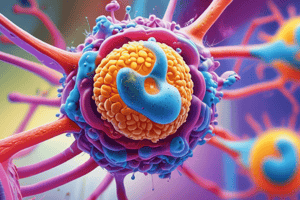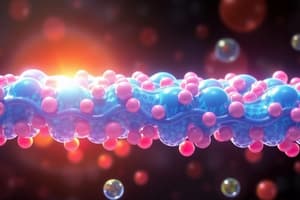Podcast
Questions and Answers
What classification of proteins is primarily found embedded within the lipid bilayer of biological membranes?
What classification of proteins is primarily found embedded within the lipid bilayer of biological membranes?
- Glycolipids
- Lipid-anchored proteins
- Peripheral membrane proteins
- Integral membrane proteins (correct)
What type of molecules can selectively extract transmembrane proteins from biological membranes?
What type of molecules can selectively extract transmembrane proteins from biological membranes?
- Cationic detergents
- Anionic detergents
- Water-soluble detergents
- Non-ionic detergents (correct)
Which function is NOT typically attributed to membrane proteins?
Which function is NOT typically attributed to membrane proteins?
- Enzymes
- Receptors
- Storage (correct)
- Transporters
Peripheral membrane proteins are characterized by which of the following?
Peripheral membrane proteins are characterized by which of the following?
Transmembrane proteins and glycolipids are typically oriented in which manner in the membrane bilayer?
Transmembrane proteins and glycolipids are typically oriented in which manner in the membrane bilayer?
What is one of the main functions of biological membranes?
What is one of the main functions of biological membranes?
Which component is found on the extracellular side of the plasma membrane?
Which component is found on the extracellular side of the plasma membrane?
Which term describes the arrangement and distribution of components in the plasma membrane?
Which term describes the arrangement and distribution of components in the plasma membrane?
Which of the following statements about the plasma membrane is incorrect?
Which of the following statements about the plasma membrane is incorrect?
What role do peripheral proteins play in the plasma membrane?
What role do peripheral proteins play in the plasma membrane?
What is the role of scramblase in membrane transport?
What is the role of scramblase in membrane transport?
Which statement about flippase is true?
Which statement about flippase is true?
What is the significance of the 'rate limiting' step in cholesterol synthesis?
What is the significance of the 'rate limiting' step in cholesterol synthesis?
In what way do lipids affect membrane composition?
In what way do lipids affect membrane composition?
What can be inferred about the synthesis of cholesterol in hepatic cells?
What can be inferred about the synthesis of cholesterol in hepatic cells?
What primarily allows the lateral diffusion of membrane proteins?
What primarily allows the lateral diffusion of membrane proteins?
Which of the following can restrict the movement of proteins within the membrane?
Which of the following can restrict the movement of proteins within the membrane?
What characterizes lipid rafts in biological membranes?
What characterizes lipid rafts in biological membranes?
Which type of protein does not penetrate the hydrophobic core of the bilayer?
Which type of protein does not penetrate the hydrophobic core of the bilayer?
What is a key feature of integral membrane proteins?
What is a key feature of integral membrane proteins?
What role do lipid rafts play in cellular function?
What role do lipid rafts play in cellular function?
Why is the diversity of membrane proteins essential for cell function?
Why is the diversity of membrane proteins essential for cell function?
Which of the following correctly describes the packing of membrane lipids around integral proteins?
Which of the following correctly describes the packing of membrane lipids around integral proteins?
What is one of the roles of cholesterol in cellular membranes?
What is one of the roles of cholesterol in cellular membranes?
Which of the following precursors is produced from cholesterol?
Which of the following precursors is produced from cholesterol?
How does cholesterol affect the fluidity of bilayers composed of sphingolipids?
How does cholesterol affect the fluidity of bilayers composed of sphingolipids?
What experimental technique can quantify the lateral movement of proteins and lipids in membranes?
What experimental technique can quantify the lateral movement of proteins and lipids in membranes?
In terms of lipid bilayer composition, what kind of domains can cholesterol help form?
In terms of lipid bilayer composition, what kind of domains can cholesterol help form?
What effect does cholesterol have on the permeability of cellular membranes?
What effect does cholesterol have on the permeability of cellular membranes?
Which hormones are considered precursors derived from cholesterol?
Which hormones are considered precursors derived from cholesterol?
What characteristic best describes the lipid bilayer within biological membranes?
What characteristic best describes the lipid bilayer within biological membranes?
Flashcards are hidden until you start studying
Study Notes
Membrane Proteins Function and Classification
- Biological membranes are composed of integral, lipid-anchored, and peripheral proteins.
- Integral membrane proteins have hydrophobic domains that span the membrane.
- Transmembrane proteins and glycolipids have asymmetric orientation in the lipid bilayer.
- Peripheral membrane proteins associate with the lipid bilayer or integral proteins without crossing the membrane.
- Non-ionic detergents are used to selectively extract transmembrane proteins.
Membrane Protein Dynamics
- Membrane proteins exhibit lateral diffusion within the lipid bilayer.
- Membrane proteins and lipids can be restricted to specific domains through:
- Protein complexes
- Tethering by extracellular or cytoskeletal macromolecular assemblies
- Intercellular protein-protein interactions
- Lipid-protein interactions (e.g., lipid rafts)
Lipid Rafts
- Lipid rafts are ordered microdomains composed of cholesterol and sphingolipids, playing a role in signaling and cellular interactions.
- They tend to form transient structures that facilitate the cluster of proteins and lipids during cellular signaling.
Membrane Protein Structure
- Integral membrane proteins typically consist of hydrophobic α helices surrounded by hydrophilic domains.
- Fatty acyl chains and polar lipid head groups interact tightly around the hydrophobic regions of these proteins.
Cholesterol in Membranes
- Cholesterol modulates membrane fluidity, making it more rigid in the presence of unsaturated fatty acids while fluidizing bilayers with saturated phospholipids.
- Functions of cholesterol include:
- Providing structural support.
- Acting as a precursor for bile acids and steroid hormones, such as estrogen and testosterone.
- Affecting permeability of cellular membranes.
Membrane Composition and Mobility
- The lipid bilayer is characterized as a two-dimensional fluid where both lipids and proteins exhibit rotational and lateral mobility.
- Fluorescence Recovery After Photobleaching (FRAP) can be used to study lateral mobility of proteins and lipids, providing insight into membrane dynamics.
Main Functions of Biological Membranes
- Serve as a cell boundary and permeability barrier.
- Facilitate transport of substances into and out of the cell.
- Enable cell communication through receptor interactions.
- Allow for cell-to-cell and cell-matrix interactions.
Key Concepts
- Membrane-spanning proteins are typically synthesized in the cytosol and can be regulated through various modifications.
- Scramblases move phospholipids bidirectionally, while flippases transport phospholipids in one direction and require ATP for function.
Studying That Suits You
Use AI to generate personalized quizzes and flashcards to suit your learning preferences.




